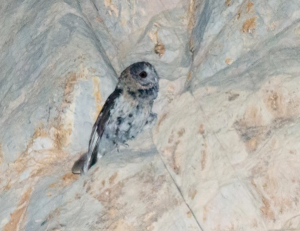The newly described taxon Strix omanensis is to be recognised as a species by BirdLife
Back in October 2013 we were pleased to announce that Magnus Robb and the rest our Sound Approach team had discovered a new species owl to science, the Omani Owl strix omanensis.
The newly described taxon Strix omanensis (Robb et al. 2013) is to be recognised as a species following application of the Tobias et al. (2010) criteria, which support its distinctiveness from congeners.
Strix omanensis was recently described from northern Oman, where it was found in the northern foothills of Al Jabal Al Akhdar, in the central part of the Al Hajar mountains (Robb et al. 2013). This was followed by the subsequent publication of a putative record c.33 km from the type locality in 2008 (van Eijk 2013).
 In the vicinity of the type locality, six or seven individuals have been found, including at least two pairs, along a c.3-km stretch of wadi (Robb et al. 2013). Given that similar habitat exists in other unsurveyed wadis near the type locality, it is thought likely that the species will be found elsewhere in the Al Hajar mountains. However, its apparent requirement for cliffs may limit its range to this massif. The nearest neighbouring mountain range is the Dhofar range of southern Oman, separated from the Al Hajar range by c.700 km of lowlying and largely barren desert. The species’s ecology may render it very rare, but for now the population size remains a matter of speculation (Robb et al. 2013).
In the vicinity of the type locality, six or seven individuals have been found, including at least two pairs, along a c.3-km stretch of wadi (Robb et al. 2013). Given that similar habitat exists in other unsurveyed wadis near the type locality, it is thought likely that the species will be found elsewhere in the Al Hajar mountains. However, its apparent requirement for cliffs may limit its range to this massif. The nearest neighbouring mountain range is the Dhofar range of southern Oman, separated from the Al Hajar range by c.700 km of lowlying and largely barren desert. The species’s ecology may render it very rare, but for now the population size remains a matter of speculation (Robb et al. 2013).
Despite the available information and possible conjecture, it may be too early to estimate the size of the species’s range and population. More study is also required into potential threats before its population trend can be reliably inferred. It is suggested that the species be listed as Data Deficient, on the basis that there is insufficient information available for a robust assessment of its extinction risk against the IUCN Red List criteria.
Above text taken from Birdlife International Globally Threatened Bird Forum. Click HERE to read full story